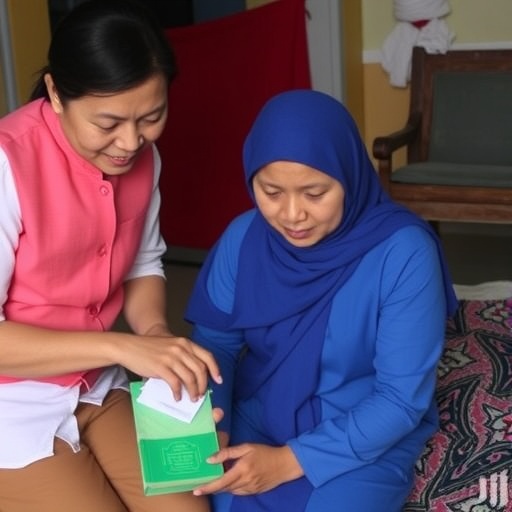In the latest comprehensive study on health economics and policy, Nguyen and Le unveil critical insights into Vietnam’s journey towards Universal Health Coverage (UHC), focusing particularly on the progress and persistent inequalities in financial risk protection. As nations around the globe strive to shield their populations from catastrophic health expenditures, Vietnam’s ambitious reforms serve as a compelling case study tracing both advancements and enduring disparities in equitably sharing health costs.
Universal Health Coverage, by definition, aims to ensure that all people obtain necessary health services without suffering financial hardship. Vietnam’s health system reforms over the past two decades have been generally heralded for expanding insurance coverage and increasing service availability. However, the question of whether this progress translates into genuine financial risk protection for all remains under rigorous scrutiny. Nguyen and Le’s analysis delves deeply into these subtleties, revealing a landscape marked by significant progress yet underscored by troubling gradients of inequality.
The research critically examines household-level data over multiple years to grasp the evolution in financial protection. By employing advanced econometric techniques, the authors meticulously quantify out-of-pocket expenditures relative to household income, assessing the incidence of catastrophic health spending—a principal indicator of financial risk. Their longitudinal approach captures shifts in health financing burdens, illuminating who benefits most and who remains vulnerable despite expanded insurance coverage.
One of the pivotal revelations is the uneven distribution of financial risk protection gains across different socioeconomic strata. While the poorest segments have gained some degree of cushioning against health-related expenditures, the extent is markedly less than in higher-income groups. This persistent stratification signals that nominal insurance enrollment does not automatically equate to effective risk mitigation. Structural barriers such as limited benefit packages, copayment requirements, and unequal access to quality care facilities continue to skew financial outcomes.
Geographic disparities emerge as another critical axis of inequality. Urban populations generally enjoy better risk protection outcomes compared to rural counterparts, reflecting disparities in healthcare infrastructure and administrative capacity. The authors highlight that rural residents disproportionately experience catastrophic expenditures due to reduced insurance coverage effectiveness and heightened reliance on out-of-pocket payments, often exacerbated by logistical challenges in accessing timely care.
Nguyen and Le further dissect the role of health insurance design in shaping financial risk landscapes. Vietnam’s mix of contributory and non-contributory schemes, each with varying benefit entitlements and eligibility criteria, creates a complex web where some groups remain inadequately covered. For instance, informal sector workers and ethnic minorities are frequently marginalized, limiting the financial risk protection that insurance promises in theory.
The dynamics of co-financing arrangements also come under scrutiny. Policy shifts aimed at increasing government subsidies for vulnerable groups have yielded measurable improvements, yet these measures fall short in fully bridging equity gaps. The uneven allocation of subsidies and administrative inefficiencies constrain the planned financial risk protections, perpetuating significant out-of-pocket burdens for disadvantaged populations.
Crucially, the study contextualizes these findings within Vietnam’s broader economic transitions and demographic shifts. Rapid urbanization, changing disease burdens, and aging populations all exert pressures on health system financing and risk protection frameworks. The authors caution that without targeted policy adjustments responsive to these evolving realities, Vietnam risks entrenching or even widening health financing inequalities.
The statistical rigor underpinning the study allows for decomposition analyses that isolate individual factors contributing to financial hardship due to health spending. This nuanced insight offers policymakers actionable intelligence: for instance, prioritizing expansion of insurance benefits coverage for chronic disease management, which disproportionately impacts older and poorer populations, emerges as a strategic imperative.
Importantly, Nguyen and Le do not merely delineate problems; they propose a refined conceptual framework to enhance financial risk protection equity. This includes advocating for integrated insurance schemes providing harmonized benefits, strengthening healthcare delivery systems in underserved areas, and enhancing transparency and accountability mechanisms within health financing institutions.
The implications of their work resonate beyond Vietnam’s borders, offering lessons for other low- and middle-income countries grappling with similar challenges in realizing UHC. The balance between expanding coverage breadth and depth, while simultaneously targeting financial risk protection, represents a universal tension in health policy that this study illuminates with empirical clarity.
Moreover, the research underscores the vital role of continuous data collection and monitoring to detect emerging inequalities and evaluate policy effectiveness. Real-time surveillance of financial risk indicators enables dynamic adjustments, preventing vulnerable groups from slipping through gaps as health systems evolve.
In summation, the study by Nguyen and Le is a timely and technically sophisticated examination of Vietnam’s path towards equitable financial risk protection in health. It blends robust empirical analysis with policy-oriented insights, making it an invaluable resource for health economists, policymakers, and advocates committed to the universal health coverage agenda.
With universal health coverage positioned as a central target of global health efforts, understanding the intersection of progress and inequalities in financial risk protection is essential. This research not only charts Vietnam’s achievements but critically exposes the systemic and structural factors that continue to compromise true equity. It is a clarion call for targeted reforms, nuanced policy design, and vigilant implementation to ensure no one is left facing catastrophic health expenses in the pursuit of health for all.
The article’s findings challenge prevailing assumptions that insurance expansion alone suffices for financial protection; instead, it highlights that comprehensive, context-specific strategies are imperative for translating coverage into real-world equity. As Vietnam advances, the lessons illuminated here will be critical in shaping a health system that is both inclusive and resilient.
Overall, Nguyen and Le’s work contributes meaningfully to the global discourse on health financing equity and the operationalization of universal health coverage, emphasizing the need for vigilance against inequalities that may otherwise be masked by aggregate progress.
Subject of Research: Financial risk protection and inequalities in health coverage in Vietnam
Article Title: Progress and inequalities in financial risk protection toward universal health coverage: insights from Vietnam
Article References:
Nguyen, P.T., Le, P.M. Progress and inequalities in financial risk protection toward universal health coverage: insights from Vietnam. Int J Equity Health 24, 287 (2025). https://doi.org/10.1186/s12939-025-02659-0
Image Credits: AI Generated




